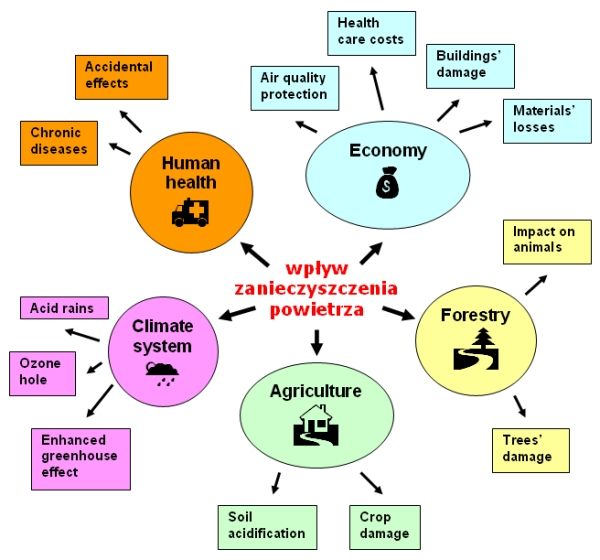|
|
 |
|
|
|
 |
| |
|
|
 |
Urban Climate
Read more |
Impact of air pollution (overview)
Air pollution may be dangerous for human health, but it also has negative impact on natural environment's functioning. Additionally, it causes economic losses. Meteorological conditions modify to a large extent the effects of air pollution. |
|
|
|
|
 |
|
Air pollution causes numerous diseases and can threaten human health and life. Air pollution usually acts gradually, in small doses, causing chronic problems with health. However, in some cases (as described in part "Urban bioclimate") they may cause even a sudden death. In the case of plants and agriculture, air pollution decreases harvests and causes acidification of the soil. In the case of forests, air pollution causes their decreased productivity and direct damage of trees. As far as global climate change is concerned, the effects of air pollution on water and plant ecosystems are the most important ones, as they influence the assimilation of CO2, one of the basic process of atmosphere-biosphere-hydrosphere gas exchange.
|
 |
 |
|
1. Air pollution impact
Authors: Anita Bokwa, Pawel Jezioro
|
|
Air pollution generates various economic losses but their detailed estimation is extremely difficult. They may be divided into four groups:
- expenses for air quality protection,
- expenses generated by the worse health condition of the society,
- losses of raw materials which become air pollution,
- losses caused by the increased corrosion of machines, buildings, and damage of historical buildings and monuments.
|
|
There is a close connection between air pollution and meteorological conditions. Main role is played by the wind which may cause fast dispersion of the pollution, but also decrease its local concentration. Transporting the pollution on large distances may cause their negative impact on ecosystems placed far away from the emission source (e.g. Siberian or Canadian taiga). On the other hand, air stagnation and temperature inversion may be dangerous when they occur in the vicinity of emission source as they unable the pollution dispersion. If a source of emission (e.g. the top of a chimney) is placed below the inversion range, the pollution does not disperse, its concentration increases and may exceed the allowed levels. In the moderate climate, the inversion occurs not only in the mountain valleys but also in the lowlands. During the inversion duration, the water vapour may reach the temperature below the condensation point. Then the fog forms which complicates the situation even more, as it contributes to the origin of the smog. It does not allow the light to come through it and therefore the ground and lower layers of the air may not be warmed, so the inversion continues. Moreover, smog contains high, dangerous concentrations of various pollutants, which caused many times intoxication and even death of many persons in large cities.
|
A good example of air pollution problems (but also how to solve them) may be Mexico City, where 3 million motor vehicles consume 17.3 million litres of gasoline and 5 million litres of diesel daily (in 1997) and generate 75% of the pollution. Ozone was above acceptable levels on 300 days in 1999. During the worst days from 1990 to 1992, pollutants hit emergency levels on as many as 177 days annually. In 1999, emergency levels occurred only on 5 days. Acceptable levels are lower than emergency levels. When emergency levels occur, the city authorities may for example limit the possibility of car usage in a city. The achievement in air pollution quality in Mexico City was considered to be a result of anti-pollution efforts by the local government. The average ozone reading fell from 197.6 (1990) to 144 (1999), where the air quality norm is 100 points of ozone-equivalent to exposure to 0.11 ppm for 1 hour. This progress in improving air quality suggests that even huge developing world cities can begin to reduce pollution.
|
 |
 |
 |
|
2. Map of Mexico.
Please click to see enlarge! (117 K)
data source: Microsoft Encarta Encyclopedia 2002
|
|
|
About this page:
Authors: Pawel Jezioro, Anita Bokwa - Jagiellonian University - Cracow / Poland
1. Scientific reviewer: Prof. Barbara Obrebska-Starkel - Jagiellonian University - Cracow / Poland - 2003-06-20
2. Scientific reviewer: Dr. Marek Nowosad - Maria Curie-Sklodowska University - Lublin / Poland - 2003-06-16
educational reviewing:
last update: 2003-12-10
|
|
 |
|









